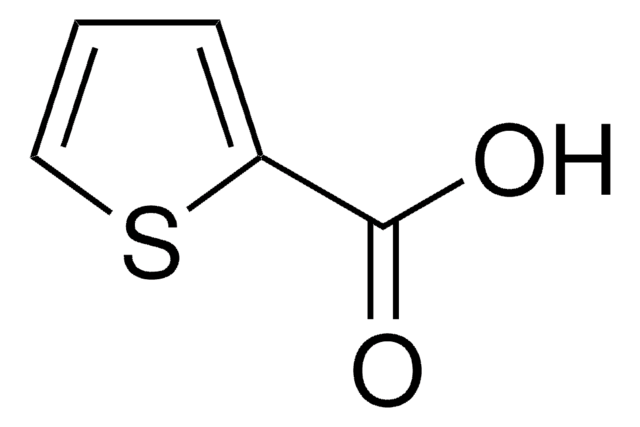W392103
Acide sorbique
≥99%, FCC
Synonyme(s) :
Acide 2,4-hexadiènoïque, C6:2n-2,4, NSC 35405, NSC 49103, NSC 50268
About This Item
Produits recommandés
Source biologique
synthetic
Agence
meets purity specifications of JECFA
Conformité réglementaire
FCC
FDA 21 CFR 166.110
FDA 21 CFR 172.872
FDA 21 CFR 177.2260
FDA 21 CFR 181.23
FDA 21 CFR 182.3089
Pression de vapeur
0.01 mmHg ( 20 °C)
Pureté
≥99%
Forme
powder
Pf
132-135 °C (lit.)
Solubilité
ethanol: 10%, clear, colorless to slightly yellow
Densité
1.2 g/cm3 at 20 °C
Traces de cations
As: ≤3.0 ppm
Cd: ≤1.0 ppm
Hg: ≤1.0 ppm
Pb: ≤2.0 ppm
Application(s)
flavors and fragrances
Documentation
see Safety & Documentation for available documents
Allergène alimentaire
no known allergens
Propriétés organoleptiques
odorless
Chaîne SMILES
C\C=C\C=C\C(O)=O
InChI
1S/C6H8O2/c1-2-3-4-5-6(7)8/h2-5H,1H3,(H,7,8)/b3-2+,5-4+
Clé InChI
WSWCOQWTEOXDQX-MQQKCMAXSA-N
Vous recherchez des produits similaires ? Visite Guide de comparaison des produits
Mention d'avertissement
Warning
Mentions de danger
Conseils de prudence
Classification des risques
Eye Irrit. 2 - Skin Irrit. 2
Code de la classe de stockage
11 - Combustible Solids
Classe de danger pour l'eau (WGK)
WGK 1
Point d'éclair (°F)
260.6 °F - closed cup
Point d'éclair (°C)
127 °C - closed cup
Équipement de protection individuelle
dust mask type N95 (US), Eyeshields, Gloves
Certificats d'analyse (COA)
Recherchez un Certificats d'analyse (COA) en saisissant le numéro de lot du produit. Les numéros de lot figurent sur l'étiquette du produit après les mots "Lot" ou "Batch".
Déjà en possession de ce produit ?
Retrouvez la documentation relative aux produits que vous avez récemment achetés dans la Bibliothèque de documents.
Les clients ont également consulté
Notre équipe de scientifiques dispose d'une expérience dans tous les secteurs de la recherche, notamment en sciences de la vie, science des matériaux, synthèse chimique, chromatographie, analyse et dans de nombreux autres domaines..
Contacter notre Service technique










